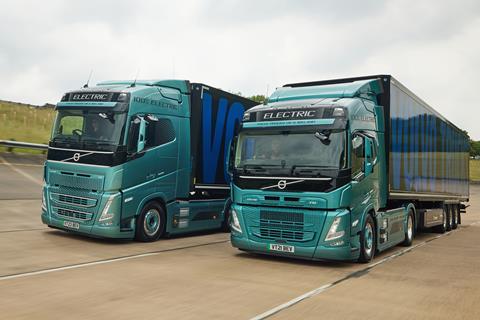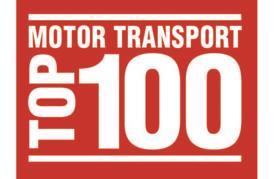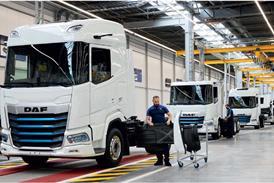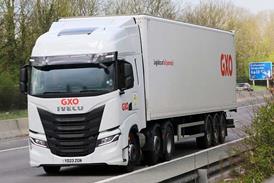
Tyre retread specialist Vaculug held its fourth Sustainability Forum at the British Motor Museum in October, bringing together operators, suppliers and leading experts to discuss the UK’s road to net zero emissions.
Sponsored by Hankook and Hireco and supported by Volvo, the event was co-ordinated by Glenn Sherwood, chief growth officer at Vaculug, which has pledged to be carbon neutral by 2030 and is the only retreader to sign up to the tyre sector’s sustainable development goals roadmap.
Sustainability is not just about the environment and carbon emissions; it also includes social and economic factors too.
Vaculug in association with Biffa has produced a free video toolbox talk on tyre safety aimed at drivers and an app listing the torque settings for wheel nuts for the majority of trucks. Designed for tyre fitters and truck technicians it is now being field tested by a number of tyre distributors.
“Wheel loss is still a big issue,” said Sherwood. “The app gives fitters easy access to the correct wheel nut torque.”
In the year to August 2024 Vaculug supplied 105,000 retreaded tyres to UK operators, saving over 7m tonnes of CO2 emissions. Working with Murfitts Industries, every truck tyre is now repurposed in some way, avoiding 5,200 tonnes of waste being sent to landfill.
“Retreads are as reliable in operation as a new tyre,” said Sherwood.
Paul Emery, Hankook Tyre UK sales director, told the forum that the tyre maker was committed to being net zero carbon emissions by 2050, with an interim target of a 46% cut by 2030.
It was doing this by using more sustainable materials such as natural oils and traceable rubber from sustainable sources on Sumatra. The aim is replace some of the 20kg to 25kg of standard rubber used in each of the 1.3m truck tyres used in the UK each year.
Hankook has developed a tyre for electric buses, which now outsell diesel vehicles in Europe, which has lower rolling resistance, extended tread life and higher load ratings for these heavier vehicles.

Dennis Evans, co-author of the book ‘The road to zero emissions: The future of trucks, transport and automotive industry supply chains’, gave his vision of the future for electric trucks.
Evans said Western Europe needed to “rethink” its approach to cutting carbon emissions from road transport.
“Net zero requires reinventing civilisation,” he went on. “It requires a radical transformation of how we consume energy and our way of life in less than three decades.
“Most logistics and distribution operators will put off the purchase of long distance, heavy electric trucks until the TCO case is proven, most likely after 2030. The 2040 deadline to stop production of internal combustion engined heavy trucks above 26 tonne GVW will have to be relaxed. It is a non-starter.”
Evans cited an International Energy Agency report that predicted several hard-to-decarbonise transport sectors including long distance road freight would “continue to release significant emissions” beyond 2070, two decades after the UK government’s 2050 target for net zero emissions.
He also quoted a leading publication on used vehicle prices which said: “The big brands will buy electric trucks to be seen to be green – but I don’t know of a finance company that will write down a £325,000 asset to zero in 60 months because we won’t have a market for used electric trucks.”
Evans added: “The predicted extended life of internal combustion engined product continues to make the residual value forecasts for electric vehicles of all weight classes very difficult if not impossible.”
He painted a bleak picture for the future of European truck OEMs in an electric world, saying that the “expertise in battery technology is embedded in tier 1 and 2 suppliers” such as Bosch, Delco, Valeo and Siemens.
Evans warned China has already “won the battery arms race” with the lion’s share of the world’s battery “gigafactories”.
“Globally, there are 136 super-sized electric vehicle battery plants in operation or being planned,” he said. “China will have 101, the USA eight and Europe just six. China is opening a battery gigafactory every week and in 2019 produced 72% of the world’s lithium-ion batteries. The UK is not even at the races.”
Asian manufacturers BYD, CATL and Panasonic dominate the vehicle battery market and Mercedes-Benz, BMW and VW Group are in negotiations with CATL to develop European gigafactories in the next three to five years.
“BYD and CATL dominate the supply chain for rare earth materials like lithium and cobalt sourced primarily from unstable markets,” said Evans. “This will be subject to pressure from solid state development over the next five years and the supply chain evolution from Asia/Africa to North America will be of great interest. Solid state batteries will be smaller and lighter and will charge in five minutes not five hours. They are the next big thing.”
He said that Chinese truck production had halved in Covid-19 and while the market was expected to recover in 2025 the five leading OEMs there would focus on producing premium vehicles rather than going for high volumes of cheap trucks.
“A massive setback in heavy truck production post-Covid will see a determination to double revenues and recover profitability through a focus on super-premium vehicles and added-value services such as battery charging and swapping, driver monitoring and remote vehicle diagnostics,” predicted Evans. “We see revenues increasing from $32bn in 2021 to $69bn in 2030.”
Volvo Trucks head of product management John Comer then ran through the EU Vecto regulations and their impact on truck builders and operators.

The vehicle energy consumption calculation tool (Vecto) is part of the “carrot and stick” approach to truck decarbonisation being adopted by the EU. It follows 30 years of constantly tightening Euro emissions standards, starting with Euro-1 in 1993 and culminating in Euro-6 in 2014, which had seen “massive cuts” in NOx and particulate matter (PM) emissions. Euro-7, due to be implemented in 2027, will further reduce NOx emissions and start to set limits of PM emissions from tyres and brakes.
Against this backdrop the Vecto rules will require progressive cuts in average theoretical CO2 emissions across each OEM’s range of heavy trucks on a 2020 baseline, starting with 15% in 2025, rising to 45% in 2030, 65% in 2035 and 90% by 2040.
While the OEMs have made huge strides in improving fuel efficiency, Comer explained the basic physics of a diesel truck which meant that 63% of the energy in the fuel was lost in heat, friction and rolling resistance.
The UK had implemented the Vecto rules in the post-Brexit transfer of EU directives as Statutory Instrument (SI) 1402 2022 but had a different target – a 30% cut in CO2 by 2030 – leading to “fragmented rules”.
The LNG engines in Volvo’s FM and FH inject a small amount of diesel to ignite the gas rather than a spark plug and have been type-approved as dual-fuel vehicles in the EU for the purposes of Vecto – but not in the UK.
As a simulation tool based on six standard vehicle types and five duty cycles, Vecto takes no account of real-world operations where the use of doubledeck trailers or low carbon fuels and improved driver performance can have significant impacts on the actual gCO2/tonne-km achieved by a truck.
“We have to spec the truck to meet the operator’s application and also meet the Vecto targets,” said Comer. “We are restricted because if we don’t meet those targets we will be fined.”
One easy win to improve a truck’s Vecto score is to fit energy efficient tyres rated A or B for rolling resistance. “Tyres have a huge influence on the Vecto result,” said Comer. “Given the load and traction forces on a truck, tyre life of up to 200,000kms is a tremendous achievement by major global brands with huge investments in R&D.”
Comer posed the question of whether under Euro-7 tyre manufacturers would be made responsible for the PM produced by their products as they wear.
He acknowledged that an operator needed the right balance between rolling resistance and mileage. Regional tyres suitable for the UK market usually start with 18mm to 20mm tread depth from new and became more energy efficient as they wear down to 7mm to 9mm.
A long-haul A-rated tyre on the other hand benefits from day one in terms of rolling resistance due to lower tread depth of 12mm to 14mm from new, but the mileage is reduced by around 25%.












![Mercedes-Benz_eActros_600_(1)[1]](https://d2cohhpa0jt4tw.cloudfront.net/Pictures/274x183/8/2/0/17820_mercedesbenz_eactros_600_11_978080.jpg)




